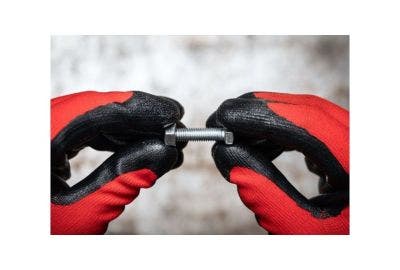Tightened fasteners contribute to overall safety, operational efficiency, and the structural robustness of an aircraft, essential factors for successful and secure aviation.
So, how can you ensure aircraft bolts and nuts remain securely fastened?
You need various tools for your aviation tool kit; continue reading to find out what these are and the tasks you should conduct to ensure the integrity of aircraft fasteners.
What Can Cause Bolts to Loosen During a Flight?

Loose bolts can be caused by numerous factors, some of which we have detailed below.
Overloading
Surpassing an aircraft's predetermined weight or stress thresholds constitutes a critical risk that extends beyond mere overloading. This dangerous scenario imposes an undue burden on the aircraft's structural integrity, exponentially amplifying the likelihood of adverse consequences.
Specifically, the heightened stress levels threaten the integrity of essential components, such as bolts, which maintain the aircraft's structural cohesion. These bolts or other fasteners may loosen if undue stress is put on them.
Gasket Creep
Gasket creep is a loss of gasket thickness and deformities that arise from pressure and temperature changes. These gradual changes result in vulnerabilities in the structural integrity of an aircraft.
The consequential impact affects the gasket and the critical juncture of bolted connections poses a risk to the structural integrity of an aircraft, particularly at those connections, and can result in compromised tightness and potential loosening during flight.
Fatigue Failure
Fatigue failure, a consequence of the relentless cyclical loading and unloading experienced by bolts, unveils a gradual erosion of structural integrity over time. Each cycle contributes incrementally to the wear and tear of these essential components.
The cumulative toll of fatigue imperceptibly weakens the bolts, rendering them susceptible to compromise and, consequently, elevating the potential for loosening during demanding flight conditions.
Thermal Expansion
Flight-induced temperature fluctuations trigger the expansion and contraction of materials, including bolts. This dynamic process can subtly alter the tightness of bolts over time, posing the risk of gradual loosening.
Vibration
The vibrational forces generated during flight, particularly in turbulent conditions, exert dynamic pressures on bolts. Prolonged exposure to these vibrations introduces a gradual but consequential impact on the robustness of bolted connections, diminishing their grip and elevating the risk of eventual loosening.
Shock
The repercussions of sudden and intense shocks, such as those incurred during hard landings or impacts, extend to the integrity of bolts within the aircraft structure. These forceful events can jolt the bolts, causing shifts and compromising their initial tightness.
Preventing Bolts from Loosening on Aircrafts

So, now you understand how essential it is to have secure fasteners on aircrafts, discover how you can prevent them from loosening.
Applying a Safe-T-Cable
Safe-T-Cables are versatile fasteners that find extensive applications in aerospace, marine, rail, and energy industries, thriving in environments marked by intense vibrations and fluctuating temperatures.
Their multi-stranded design ensures a harmonious blend of strength and flexibility, catering to the dynamic demands of these challenging settings.
Their resilience to temperature fluctuations prevents loosening caused by thermal cycling, underscoring their reliability. Additionally, they excel in shock absorption, serving as invaluable components across high-performance and safety-critical industries where impact resilience is paramount.
Furthermore, their lightweight nature makes them ideal for weight-sensitive applications, enhancing fuel efficiency and performance, particularly in autosport.
Applying the Proper Amount of Torque
Precise torque application is essential in maintaining the structural integrity of assembled components, particularly in critical sectors like aerospace, automotive, and machinery.
Deviations in torque pose distinct risks. For example, insufficient torque can cause loose fasteners and component failure, while excessive torque may lead to overloading and potential damage.
Striking the right balance is crucial for preventing under-tightening and over-tightening issues, contributing to the assembly's long-term reliability and safety.
Specialised tools, such as torque wrenches, are key in achieving accurate and consistent torque.
Available in various types, including preset and adjustable torque wrenches, these tools ensure adherence to torque specifications, further enhancing the durability and safety of assembled structures.
Maintaining the Bolts
Regular visual examinations of bolts, nuts, and screws, complemented by torque checks, play a pivotal role in promptly detecting any indications of loosening or wear. Timely retightening ensures the sustained tension necessary to avert potential failures, contributing to the overall longevity and reliability of the assembly.
Mitigating the detrimental effects of corrosion is equally crucial. Employing corrosion-resistant coatings, opting for materials like stainless steel, and storing fasteners in dry conditions collectively serve as proactive measures against corrosion.
These preventive measures extend the fasteners' lifespan and fortify the entire system's integrity, reinforcing the importance of a comprehensive maintenance approach.
To conclude, the appropriate steps and tools we've explained in this blog can help reduce the likelihood of fasteners loosening on aircrafts, increasing overall safety and the longevity of applications.
Explore Heamar’s power tools and accessories if you require high-quality equipment to assist with other tasks, whether in the aviation industry or other professional environments.





















